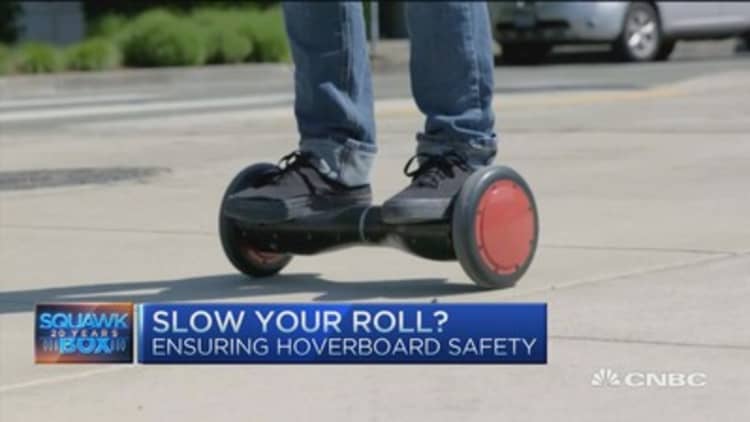
Hoverboards have seen a recent uptick in popularity, especially as a holiday gift for the techies in your life. But airline authorities are warning about packing them onto a flight this holiday season, and some carriers have even banned them outright.
On Thursday, Delta Air Lines banned hoverboards in carry-on and checked baggage, citing the product's fire hazard risk. and JetBlue, among others, also bar the devices from flights.
Federal safety regulators have also stepped up an investigation of the hoverboards following reports of fires and explosions. The Consumer Product Safety Commission told NBC News it received "at least 10" reports of hoverboard fires and that that number is increasing daily.
Hoverboards are powered by lithium-ion and lithium-metal batteries. If metal objects such as keys, coins, tools or other batteries come in contact with both ends of these batteries, it can create an electrical current which can cause extreme heat and sparks and even start a fire.
Concerns about the batteries' safety on planes have increased. By the end of June of this year, 158 incidents "involving batteries carried as cargo or baggage" (several of which involved burning and smoke) had been recorded by the Federal Aviation Administration since March 1991.
The FAA only permits spare, uninstalled lithium-ion and lithium-metal batteries in carry-on baggage. Lithium-metal batteries are limited to 2 grams of lithium per battery and lithium-ion batteries are limited to a rating of 100 watt hours per battery, a threshold the agency said should allow for nearly all types of electronic devices used by the average person.
Furthermore, the FAA requires that passengers seek airline approval if they wish to carry up to two additional spare larger lithium-ion batteries at 101-160 watt hours each. Even when a carry-on bag is checked at the gate, the FAA asks that all spare lithium batteries are removed and kept with passengers in the aircraft cabin.
The lithium-ion rating on some models, like those sold by hoverboard manufacturer Swagway, measures in at 158 watt hours, putting it under the FAA's maximum limit of 160 watt hours. However, the company still urges extra caution.
"Our position on the question about flights is that while technically it does seem to fall under the guidelines as required by the FAA, we do not recommend taking the Swagway as a carry-on, as each carrier will vary on what they may allow, based on their individual comfort levels," the company stated in an email to CNBC.
"These types of boards are new so there seems to be a lot of varying information out there, but for sake of safety, we can't stress enough how the caliber of the components used can make an impact in the overall safety of these boards."
See below for other specific airlines' takes on carrying hoverboards aboard flights:
-
United: Allowed in carry-on and checked luggage as long as the device meets FAA guidelines and size limits.
-
American: Allowed in carry-on luggage if it meets the airline's carry-on policy as well as government guidelines.
-
Southwest: Preferred in carry-on luggage if the battery is under 160 watt hours but is also allowed in checked luggage if the device fails to meet carry-on weight and size guidelines.
-
Frontier: Not allowed in checked or carry-on luggage.






